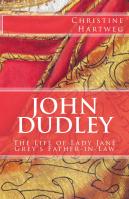According to the book Leicester’s Commonwealth (written in about 1584 by angry Catholic exiles), Robert Dudley had “but two ancestors”. Those being his father, John Dudley, and his grandfather, Edmund Dudley. John Dudley in turn became Viscount Lisle, Earl of Warwick, and Duke of Northumberland, while Edmund Dudley functioned among other things as Speaker of the House of Commons and tax collector of Henry VII. So far, so good, but Robert Dudley’s great-grandfather was supposed to have been a mere carpenter, according to the same book.
John Dudley of Atherington, father of Edmund, was not a carpenter but a country gentleman. He was a younger son of the major baron, John Dudley, or Sutton, of Dudley castle, the first Lord Dudley to be summoned to parliament as a peer of England in 1440. The Suttons of Dudley castle were a family of magnates going back at least four generations before they were summoned to parliament, and, fittingly, John Sutton the first baron was also the first to call himself Dudley instead of Sutton. Born on Christmas Day 1400 and living to the ripe age of 87, he served a handful of monarchs during the Hundred Years War and the Wars of the Roses, finding himself always on the winning side. He also served as Lord Lieutenant of Ireland between 1428 and 1430.
One of the four sons of John Sutton alias Dudley was William Dudley, Bishop of Durham from 1476–1483. The first baron was succeeded by his grandson, Edmund, second Lord Dudley and son of Sir Edmund Dudley. John Dudley of Atherington (the supposed carpenter) was thus the uncle of the new baron, while his son Edmund was the latter’s first cousin. Edmund was to be Robert Dudley’s grandfather.
Robert’s most illustrious ancestors, however, derived from his paternal grandmother, Edmund’s second wife, Elizabeth Grey. She was the daughter of Edward Grey, 1st Viscount Lisle, who had been created a viscount because of his wife, Elizabeth Talbot. Elizabeth Talbot was the daughter and eventual heiress of John Talbot, 1st Viscount Lisle (1423–1453), the first son of the famous John Talbot, 1st Earl of Shrewsbury, by his second wife, Margaret Beauchamp. Margaret happened to be heiress to the Lisle barony via her great-great-grandfather Gerard de Lisle (d.1360). She was also directly descended from King Edward I. Thus, Robert Dudley was among the many courtiers of the Tudor court who could count this king among their ancestors.
Margaret Beauchamp was above all the eldest daughter of Richard Beauchamp, 13th Earl of Warwick, and his first wife, Elizabeth de Berkely (daughter of Thomas, 5th Lord Berkely). Robert Dudley, when Earl of Leicester, was to pick a seemingly endless quarrel with his relatives the barons of Berkely about disputed landholdings. In the end he prevailed, but only because Queen Elizabeth decided in his favour.
Margaret Beauchamp’s father, the 13th Earl of Warwick, is chiefly known as governor of the young person of King Henry VI and, of course, for his beautiful funeral monument in the Beauchamp Chapel of St. Mary’s Church, Warwick. This chapel was also to become the final resting place of Robert Dudley, his little son Lord Denbigh, his wife Lettice (née Knollys), and his brother Ambrose Dudley, Earl of Warwick. According to his will, Robert wished to be buried “where sundry of my ancestors do lie”.

Robert Dudley’s reconstructed gardens at Kenilworth Castle: The bear and ragged staff, the heraldic symbols of the ancient earls of Warwick which Robert also adopted. Photo by Richard Croft CC BY-SA 2.0.
The ancient earldom of Warwick obviously mattered a lot. John Dudley received it in 1547 and took as his arms the bear and ragged staff. His sons, Ambrose and Robert, continued to use these heraldic symbols under Elizabeth I, having been created earls of Warwick and Leicester, respectively.
On 12 March 1542, King Henry VIII created Robert’s father, John Dudley, Viscount Lisle – “in right of his mother”. The previous holder of the title, the king’s illegitimate half-uncle Arthur Plantagenet, had died nine days before. Arthur Plantagenet had become Viscount Lisle in recognition of his marriage to John Dudley’s mother (Elizabeth Grey), who herself had become Baroness Lisle in her own right after the deaths of her brother (John Grey, 2nd Viscount Lisle, 1481–1504) and her niece (another Elizabeth Grey, Baroness Lisle and temporary fiancée and ward of Charles Brandon, later Duke of Suffolk).
Robert Dudley also had noble ancestors through his mother, Jane Guildford. Her mother was Eleanor West, daughter of Thomas West, 8th Lord De La Warre and 5th Lord West. The barons West and De La Warre went back to the 13th century, being first summoned to parliament in the early 14th century. A descendant of the 8th Lord (Robert Dudley’s great-grandfather) was Thomas West, 12th Lord De La Warre, who married Anne Knollys, Lettice Knollys’ sister, and acted as governor of Virginia from 1610–1618. He gave his name to the U.S. State of Delaware.




Eight x Great Grandson of King Edward I.
Paternal Family Tree:
http://www.thehistorydatabase.com/PFAMILYTREES/ENGLAND/SUTTON.HTML#Robert%20Dudley%201st%20Earl%20Leicester%201532-1588